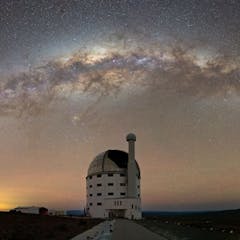
Artículos sobre Astronomy
Mostrando 41 - 60 de 797 artículos

Mars has been a popular destination since space exploration began – and there are plenty of people who’d love to go there.

Orbital resonance is kind of like musical harmony, but systems that display it are far more rare than songs with harmonic melodies.

When most of us left school there were still 9 planets – but we’ve come a long way since Pluto’s demotion. Here’s what’s next on the space agenda.

Japan is one of several countries that weren’t part of the space race of the 1950s and 1960s looking toward the Moon. They’ve now become the 5th country to have landed on its surface.

The astronomical community has thrived and world-class astronomical facilities have been established in South Africa.

You might hate winter, but at least you know what to expect every year. Other planets have wobbly axes that lead to wild, unpredictable seasons.

After a decade studying thousands of supernovae, astronomers are still perplexed by the enigma that led Einstein to his ‘greatest mistake’.

The nature of dark energy remains one of the biggest puzzles in cosmology.

A team of archaeologists discovered the remains of the 16th-century father of modern astronomy, who demonstrated that the Earth orbits the Sun.

In 2024 we will see meteor showers, Saturn disappearing behind the Moon, and – if we’re lucky – a comet bright enough to see with the naked eye.

The Peregrine and Nova-C landers are due to carry out valuable science at two diverse lunar locations.

A telescope can reveal so much of the night sky, including Saturn’s rings and the Moon’s craters. But choosing the right telescope is a difficult decision – here’s what you need to know.

People have been looking up at the stars for thousands of years. Here’s where to start if you want to learn more about the night sky – from spotting easy-to-find constellations to using the best apps.

Pictures of black holes have a white outline around them when photographed, due to one of black holes’ unique and key features.

Several scientific projects are aiming to investigate UFO sightings.

Do all big black holes in very massive galaxies emit radio waves? We used the latest radio telescopes to find out.

Sound needs matter to propagate, so the vast vacuum of space is not just empty − it’s silent.

A newly discovered planet that should be too big to have formed around a tiny star is throwing into question what researchers know about planet formation.

Five of the Uranus moons might be ocean worlds − and if there’s water, there might be life.

With an evidence-based strategy and careful evaluation, gender parity in science is achievable.
